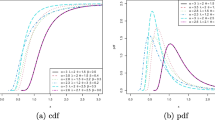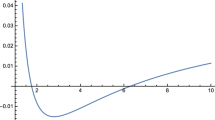Abstract
With the objective of modelling annual rainfall maximum intensities in different geographical zones of Chile, we have created a Bayesian inference method for the generalized extreme value type I distribution (Gumbel distribution). We considered an uninformative prior distribution for the location parameter, μ, and three different prior distributions for the scale parameter, σ. Under these conditions we obtained the posterior distribution of (μ, σ) and associated summary statistics such as modes, expected values, quantiles and credibility intervals. In order to predict and estimate return periods, we obtained the posterior distribution of future observations, its expected value, quantiles and credibility intervals. To obtain several of these posterior summary measures it was necessary to utilize both numerical and Laplace approximations. Furthermore we estimate return period curves and intensity–duration–frequency curves.




Similar content being viewed by others
References
Al-Aboud FM (2009) Bayesian estimations for the extreme value distribution using progressive censored data and asymmetric loss. Int Math Forum 4:1603–1622
Ali-Mousa MAM, Jaheen ZF, Ahmad AA (2002) Bayesian estimation, prediction and characterization for the Gumbel model based on records. Statistics 36:65–74
Bernard MM (1932) Formulas for rainfall intensities of long durations. Trans ASCE 96:592–624
Chechile RA (2001) Bayesian analysis of gumbel distributed data. Commun Stat Theory Methods 30:485–496
Chen MH, Shao QM, Ibrahim JG (2000) Monte Carlo methods in Bayesian computation. Springer series in statistics. Springer, New York
Chow VT, Maidment DR, Mays LW (1988) Applied hydrology. McGraw-Hill, Maidenhead
Coles SG, Pericchi L (2003) Anticipating catastrophes through extreme value modelling. J Royal Stat Soc 52:405–416
Coles SG, Powell EA (1996) Bayesian methods in extreme modelling: a review and new developments. Int Stat Rev 64:119–136
Coles SG, Tawn JA (1996) A Bayesian analysis of extreme rainfall data. J Royal Stat Soc 45:463–478
Fúquene J, Pérez ME, Pericchi LR (2013) An alternative to the inverted gamma for the variances to modelling outliers ans structural brearks in dynamic models. Braz J Probab Stat. Accepted Manuscript
Gelman A (2006) Prior distributions for variance parameters in hierarchical models (Comment on Article by Browne and Draper). Bayesian Anal 1(3):515–534
Gradshteyn IS, Ryzhik IM (2000) Table of integrals, series, and products, 6th edn. Academic Press, San Diego
Guttman NB (1993) The use of L-moments in the determination of regional precipitation climates. J Clim 6:2309–2325
Haddad K, Rahman A, Green J (2011) Design rainfall estimation in Australia: a case study using L moments and generalized least squares regression. Stoch Environ Res Risk Assess 25:815–825
Hosking JRM, Wallis JR (1997) Regional frequency analysis: an approach based on L-moments. Cambridge University Press, Cambridge
Johnson NL, Kotz S, Balakrishnan N (1995) Continuous univariate distributions, 2nd edn, vol 2. Wiley, New York
Koutsoyiannis D, Kozonis D, Manetas A (1998) A mathematical framework for studying rainfall intensity–duration–frequency relationships. J Hydrol 206:118–135
Ngongondo CS, Xu CY, Tallaksen LM, Alemaw B, Chirwa T (2011) Regional frequency analysis of rainfall extremes in Southern Malawi using the index rainfall and L-moments approaches. Stoch Environ Res Risk Assess 25:939–955
Pérez ME, Pericchi LR (2012) The Scaled Beta2 distribution as a robust prior for scales, and a explicit horseshoe prior for locations. Technical Report. Centro de Bioestadística y Bioinformática, Universidad de Puerto Rico, http://repositorio.upr.edu:8080/jspui/handle/10586%20/148
Pizarro R, Abarza A, Flores JP (2001) Análisis comparativo de las curvas intensidad-duración-frecuencia (idf) en 6 estaciones pluviográficas (vii región del maule, chile). Revista Virtual de UNESCO. http://www.unesco.org.uy/phi/biblioteca/handle/123456789/500
Pizarro R, Aravena D, Macaya K, Abarza A, Cornejo M, Labra M, Pavez M, Román L (2007) Curvas intensidad-duración-frecuencia para la zona centro sur de chile. Revista Virtual de UNESCO. http://www.unesco.org.uy/phi/biblioteca/handle/123456789/478
Sarkar S, Goel NK, Mathur BS (2009) Development of isopluvial mao using L-moment approach for Tehri-Garhwal Himalaya. Stoch Environ Res Risk Assess 24:411–423
Schaefer MG (1990) Regional analyses of precipitation annual maxima in Washington State. Water Resour Res 26:119–131
Yang T, Xu CY, Shao QX, Chen X (2010) Regional flood frequency and spatial patterns analysis in the Pearl River Delta region using L-moments approach. Stoch Environ Res Risk Assess 24:165–182
Acknowledgements
This work has been supported by FONDEF-D08I1054 and FONDECYT-1130375, Chile. We thank reviewers for their constructive and helpful comments on this article.
Author information
Authors and Affiliations
Corresponding author
Rights and permissions
About this article
Cite this article
Vidal, I. A Bayesian analysis of the Gumbel distribution: an application to extreme rainfall data. Stoch Environ Res Risk Assess 28, 571–582 (2014). https://doi.org/10.1007/s00477-013-0773-3
Published:
Issue Date:
DOI: https://doi.org/10.1007/s00477-013-0773-3




